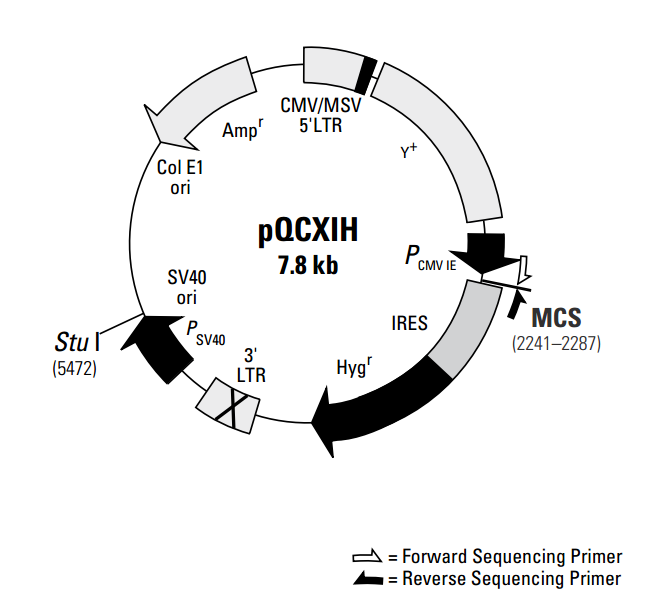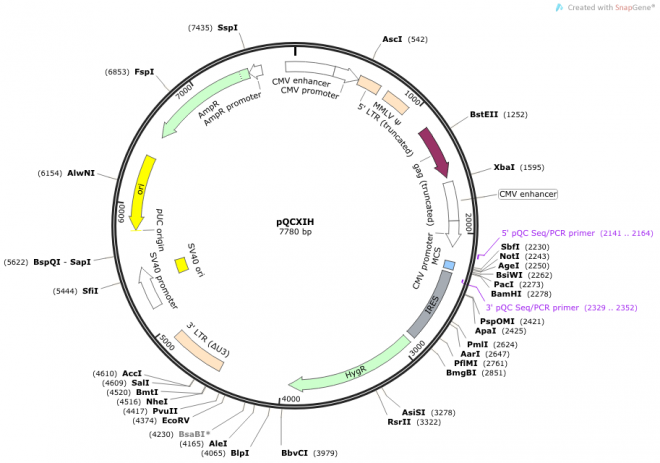pQCXIH 载体
| 质粒类型: | 逆转录病毒载体 |
|---|---|
| 高拷贝/低拷贝: | 低拷贝 |
| 启动子: | CMV |
| 载体大小: | 7780 bp (查看载体序列) |
| 5' 测序引物及序列: | pQC-F: ACGCCATCCACGCTGTTTTGACCT |
| 3' 测序引物及序列: | pQC-R: AAGCGGCTTCGGCCAGTAACGTTA |
| 载体抗性: | Ampicillin (氨苄青霉素) |
| 筛选标记: | Hygromycin(潮霉素) |
| 备注: | 自失活双顺反子逆病毒表达载体,含有IRES-Hygromycin元件,能够同时表达目的蛋白和潮霉素抗性筛选标记,可以用来构建稳表达细胞系。 |
pQCXIH Retroviral Vector is a self-inactivating bicistronic expression vector designed to express a target gene along with the hygromycin resistance gene (1). Upon transfection into a packaging cell line, this vector can transiently express, or integrate and stably express, a viral genomic transcript containing the CMV immediate early promoter, gene of interest, IRES and the hygromycin resistance gene (Hygr). The gene of interest and the hygromycin resistance gene are co-translated, via the internal ribosome entry site (IRES), as a bicistronic message in mammalian cells (2, 3).
This vector incorporates unique features including: optimization to remove promoter interference and self-inactivation. The hybrid 5' LTR consists of the cytomegalovirus (CMV) type I enhancer and the mouse sarcoma virus (MSV) promoter. This construct drives high levels of transcription in HEK 293-based packaging cell lines due, in part, to the presence of adenoviral E1A (4, 5, 6, 7) in these cells. The self-inactivating feature of the vector is provided by a deletion in the 3' LTR enhancer region (U3). During reverse transcription of the retroviral RNA, the inactivated 3' LTR is copied and replaces the 5' LTR, resulting in inactivation of the 5' LTR CMV enhancer sequences. This may reduce the phenomenon known as promoter interference (8) and allow more efficient expression.
Also included in the viral genomic transcript are the necessary viral RNA processing elements including the LTRs, packaging signal (Psi+), and tRNA primer binding site. pQCXIH also contains a bacterial origin of replication and E. coli Ampr gene for propagation and selection in bacteria.
载体应用
pQCXIH is designed to deliver and express a gene of interest, along with the hygromycin resistance marker, from a bicistronic message. The design is optimized to produce high titers via the PCMV IE in the packaging cell line. The bicistronic transcript makes it unnecessary to screen the transformants since the Hygromycin resistance is expressed in concert with the gene inserted into the multiple cloning site.
Once transfected into the packaging cell line (such as the RetroPack™ PT67 Cell Line; Cat. No. 631510), RNA from the vector is packaged into infectious, replication-incompetent retroviral particles since pQCXIH lacks structural genes (gag, pol, and env) necessary for particle formation and replication; however, these genes are stably integrated as part of the packaging cell genome. Once a high titer clone is selected, these retroviral particles can infect target cells and transmit the gene of interest but cannot replicate within these cells due to the absence of viral structural genes. The separate introduction and integration of the structural genes into the packaging cell line minimizes the chances of producing replication-competent virus due to recombination events during cell proliferation.



